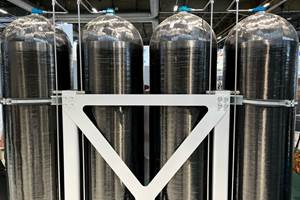Aerospace and industrial composites: Now on divergent paths?
The aerospace and industrial markets’ advanced composites challenges and their solutions will differ widely.
Share
Late in 2014, I wrote several columns that pointed to a convergence between the aerospace and industrial markets for advanced composites. Several signs pointed to this. SAMPE and ACMA came together that October to form a single CAMX trade show and conference, covering all composites applications. Composites Technology and High-Performance Composites became this single magazine, called CompositesWorld. In the final issue of Composites Technology (December 2014), I opined, “We’re moving toward a time when aerospace and automotive technical advances will be interchangeable and extend well beyond the use of carbon fiber.” Additional columns in the months following built on this theory of convergence, noting the contributions of aerospace, like software tools for composites and nondestructive evaluation to the advances of composites in industrial applications, and the efforts in high-speed fabrication in automotive finding eventual use in aerospace.
The convergence model can be illustrated by two highways coming together to form a super-highway to a common destination. After decades of crossing widely disparate materials, processes and designs — both markets now chase similar objectives for multi-material solutions, lower costs and higher volumes.
But what if this isn’t a merging of traffic, but merely an intersection? Or, to continue the highway metaphor, a “roundabout,” where two streams of traffic enter, but the majority continues out via separate roads to different destinations? What if the past two years have simply been a transient moment in time and technology where there was a lot of common territory?
The event that triggered these thoughts was the CompositesWorld Carbon Fiber conference in November. The first day was very aerospace-focused. Day two focused on automotive and low-cost, alternative precursors for carbon fiber. As I listened to presentations, it struck me that each market faces very different challenges. And that solutions will differ widely as well.
Start with carbon fiber. The major suppliers of aerospace-qualified carbon fiber could cut the price in half, and it would have a negligible effect on the size of the aerospace carbon fiber market. It is just not that sensitive to material pricing, which represents less than 20% of part costs. On the other hand, if the price of industrial-grade carbon fiber were suddenly reduced by 50%, it would open big opportunities in automotive and wind energy markets. One could argue that this is a prerequisite to achieve significant penetration and helps explain the strong interest in alternative precursors such as textile PAN, bio-based PAN and pitch.
Significant levels of automation are being developed for both aerospace and automotive. A lot of effort is going into machines to make simple, repetitive carbon fiber elements for aircraft — beams, stringers and frames, for example. This is in addition to multi-million-dollar fiber placement machines already prevalent in wing and fuselage layup, where the molds remain stationary and only the gantry and heads move. The layup machines under development for automotive are focused on small- to medium-sized parts, principally laying up 2D patterns, using wider tapes, with shaping happening during the molding process. These machines have relatively small footprints, move the table as much as the head, and are a fraction of the cost of the aerospace machinery.
Finally, the markets’ volume levers are distinctly divergent. Chris Red of Composites Forecasts and Consulting LLC (Mesa, AZ, US) estimates that commercial aircraft structures consumed 7,500 MT of carbon fiber in 2016, and this will grow to slightly more than 10,100 MT in 2025, an increase of about 35%. This represents maturation of widebody aircraft programs and organic market growth. Should Boeing and Airbus elect to put carbon fiber wings on every narrowbody aircraft built (admittedly, a very optimistic scenario) this would add 7,000 MT to this forecast, at 5 MT per aircraft, assuming growth to 1,400 aircraft per year. For OEM automotive, Red’s numbers go from just under 12,000 MT to almost 33,000 MT in the same period, nearly tripling the market. And his numbers might be low. Andreas Wuellner of SGL Carbon Fibers (Wiesbaden, Germany) envisions 20% of the world’s 100 million vehicles built in 2025 using 2 kg each — an annual market of 40,000 MT. This isn’t exactly a stretch, either. It could easily be double or even quadruple this figure with just a few technology breakthroughs.
As both markets drive through the roundabout into the future, we could be looking at very distinct industries, with different casts of suppliers, manufacturers and technologies. And surprisingly little crossover.
Related Content
“Structured air” TPS safeguards composite structures
Powered by an 85% air/15% pure polyimide aerogel, Blueshift’s novel material system protects structures during transient thermal events from -200°C to beyond 2400°C for rockets, battery boxes and more.
Read MoreRecycling hydrogen tanks to produce automotive structural components
Voith Composites and partners develop recycling solutions for hydrogen storage tanks and manufacturing methods to produce automotive parts from the recycled materials.
Read MoreMcLaren celebrates 10 years of the McLaren P1 hybrid hypercar
Lightweight carbon fiber construction, Formula 1-inspired aerodynamics and high-performance hybrid powertrain technologies hallmark this hybrid vehicle, serve as a springboard for new race cars.
Read MoreComposites end markets: Automotive (2024)
Recent trends in automotive composites include new materials and developments for battery electric vehicles, hydrogen fuel cell technologies, and recycled and bio-based materials.
Read MoreRead Next
Plant tour: Daher Shap’in TechCenter and composites production plant, Saint-Aignan-de-Grandlieu, France
Co-located R&D and production advance OOA thermosets, thermoplastics, welding, recycling and digital technologies for faster processing and certification of lighter, more sustainable composites.
Read MoreAll-recycled, needle-punched nonwoven CFRP slashes carbon footprint of Formula 2 seat
Dallara and Tenowo collaborate to produce a race-ready Formula 2 seat using recycled carbon fiber, reducing CO2 emissions by 97.5% compared to virgin materials.
Read MoreVIDEO: High-volume processing for fiberglass components
Cannon Ergos, a company specializing in high-ton presses and equipment for composites fabrication and plastics processing, displayed automotive and industrial components at CAMX 2024.
Read More




















